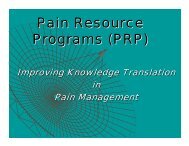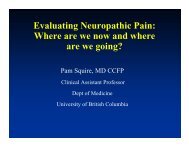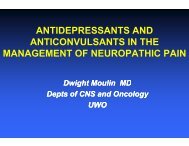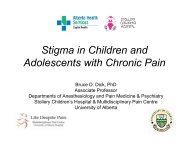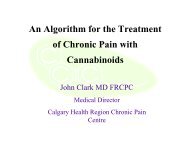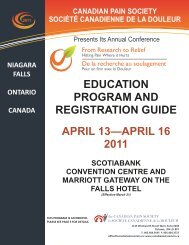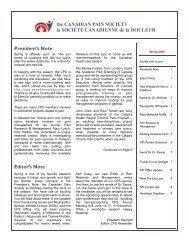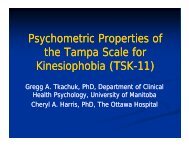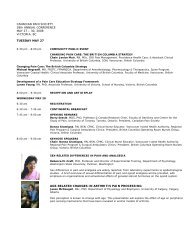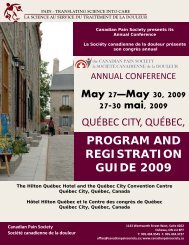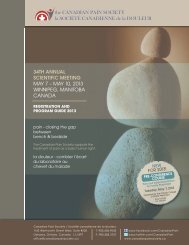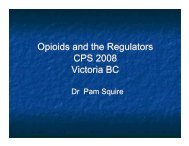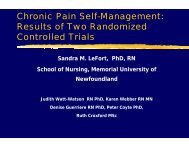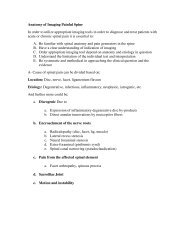Understanding Chronic Post Surgical Pain - The Canadian Pain ...
Understanding Chronic Post Surgical Pain - The Canadian Pain ...
Understanding Chronic Post Surgical Pain - The Canadian Pain ...
Create successful ePaper yourself
Turn your PDF publications into a flip-book with our unique Google optimized e-Paper software.
A review of chronic pain after surgeryDr Julie Bruce, Senior Research FellowEpidemiology Group,University of Aberdeen, Scotland, UKj.bruce@abdn.ac.uk
Session objective“To examine methodological issues related to thedefinition and measurement of persistent chronic postsurgicalpain”- EpidemiologyDefinitions & case-ascertainment- Risk factors for CPSP- Model for investigation
DefinitionIASP – chronic pain“Intermittent or continuous pain persisting beyond normal tissuehealing time”“3 months most convenient division between acute & chronic butfor research purposes, 6 months will often be preferred”Criteria for CPSP (Macrae & Davies, 1999):i. <strong>Pain</strong> must develop after a surgical procedure;ii. <strong>Pain</strong> is of at least 2 months duration;iii.iv.Other causes for the pain have been excluded;<strong>The</strong> possibility that the pain is from a pre-existing problemshould be explored and exclusion attempted.
Terminology<strong>Chronic</strong> post-surgicalsurgical pain<strong>Post</strong>-surgical neuralgia<strong>Post</strong>-operative ti traumatic ti nerve injuryNeuroma painPersistent scar painProcedure-specific pain syndromes<strong>Post</strong>-mastectomy pain syndrome (PMPS)<strong>Post</strong>-axillary dissection painIntercostobrachial nerve entrapment syndrome (INES)Phantom painStump pain<strong>Post</strong> thoracotomy pain syndromeInternal mammary artery syndrome (IMAS) ………etc
CharacteristicsPredominantly neuropathic (Kehlet 2006, Steegers 2008)Sensation– Loss of sensation of touch, temperature, pressureHypersensitivity– Paresthesia by non-noxious stimuli, symptoms continuous orspasmodic– Hypersensitivity can mask sensory lossDescriptors– Stabbing, shooting, burning, numbness, pins & needles,tingling…..
MeasurementClinical vs epidemiological approachClinicalIndividualDetailed assessmentTargeted treatmente.g. pain clinicEpidemiologicalPopulation level lHistorical cohortCross sectional surveyProspective cohort
Epidemiological studiesCase ascertainmentDefining ‘chronic’2, 3 or 6 months after surgeryHave you had pain in the last day?Have you had this pain for more than 3 months?Attributable to surgery?Is this pain the same as the pain before surgery? [recall bias]Is the pain due to surgery?
<strong>Surgical</strong> cohort studiesModel for investigationPre?Acute postop painCPSPSURGERY 3 months 1 year 3 years<strong>Pain</strong> characteristicstiIntensityCharacter:Impact on QoL:Timeline:VAS, VRS, BPIMPQ, SF-MPQ, s-LANSS, DN4BPI, SF36 etconset & pattern
Case ascertainmentMethodological challengesPt. 1Acute postop pain CPSP <strong>Pain</strong> resolvedPt. 2AcuteCPSPSURGERY 3 months 3 yearsCPSP? 3 months3 yrsPt 1. Yes No BUT contributes to cumulative prevalencePt 2. Yes?? Yes
Burden of diseaseHow common is CPSP?Historically,- Rare syndrome, literature from 1970s: 0.1% to 4%- ‘mild side effect’ of surgery (Brit J Cancer, 1992)Crombie et al. (1998)• Survey of UK chronic pain clinics
<strong>Chronic</strong> pain after breast surgerySee reviews: Jung 2003; Macrae 2008; Macrae & Bruce 2008Authors Country Year S/Size <strong>Pain</strong> (%) Follow-upJamison USA 1979 41 44 2 yrKroner Denmark 1989 110 23 1 yrVecht Netherlands 1990 38 18 6 monthsKroner Denmark 1992 69 17-31 6 yrPolinsky USA 1994 223 22-32 8 yrStevens USA 1995 95 20 NRTasmuth Finland 1995 93 24 1 yrTasmuth Finland 1995 469 49 2 yrWallace USA 1996 282 31-49 1 yrSmith Scotland 1999 408 43 3 yrJohansen Denmark 2000 266 15 6 yrFassoulaki Greece 2002 75 33 3 monthsFassoulaki Greece 2005 55 57 6 monthsMacdonald Scotland 2005 175 50 9 yrs
Authors Search IncludedpapersS/SizeDefinition ofCPSP% <strong>Pain</strong>Poobalan1987-N=40 Any >3 months 10-30%et al. 2000(5% severe)Aasvang& Kehlet2000-2003N=35 >100 > 6 months CPSP 12%Testicular pain6%• 8/40 studies gave explicit definition for ‘chronic pain’• <strong>Pain</strong> primary outcome = higher prevalence (n=6; n=16)CJP 2003; BJA 2005
<strong>Chronic</strong> pain after hernia surgeryIncreasing recognitionRecent reviews:-van Hanswick, Lloyd, Horstall, Tan, O’Dwyer. <strong>The</strong> measurement of chornic pain& HR-QoL following inguinal hernia repair: a review of the literature. Hernia;2008: 561-9.Nienhuijs, Rosman, Strobbe, Wolff, Bleichrodt. An overview of the featuresinfluencing pain after inguinal hernia repair. Int J Surg, 2008; 4: 351-6.Nienhuijs, Staal, Strobbe, Rosman, Groenewoud. <strong>Chronic</strong> pain after mesh repairof inguinal hernia: a systematic review. Am J Surg. 2007; 3: 394-400.400.Important surgical outcome – recurrence & chronic pain (UK NICE)
Public health burdenPopulation o at risk?Procedure Number procedures peryearCanada*2000 DataUSA †1994 DataCPSPprevalenceestimatesEstimatedburden~5% @1 yr[severe]Mastectomy 14,438438 131,000 20-50% 7271Thoracotomy 16,305 660,000 5-65% 33,815Hysterectomy 55,404 - 16-50% 2770Hip & knee 41,502 - 3-30% 2075Limb amputation - 132,000 50-80% 6600Cardiac surgery - 501,000 30-55% 25,050Hernia - 689,000 5-30% 34,450*CIHI data - Goldstein 2004; † Rutgow 1997> 100,000
Prognosis: long-term outcome?Smith et al. 1999; Macdonald et al. BJC 2005• 175/ 408 (43%) with CPSP 3 years after breast ca surgery• Re-assessed CPSP group at 9 years, 113/138 (82%)50% pain resolved- QoL scoresimprovedLower QoL inpatients with CPSP(P
<strong>Chronic</strong> post-surgical painRisk factors
Demographic factorsYounger age- breast, hernia, cardiac, thoracic(e,g, Maguire, 2006)- 2 studies with similar probabilities- pain decreases 5% each 1yrincrease in age (Poobalan 2001 &Poleshuck, 2006)- severe pain common in youngerAgeBreastN=408Aberdeen studies*% CPSPHerniaN=351CardiacN=108070 26% 14% 34%patients (Aasvang & Kehlet, 2005) *Smith 1999; Poobalan 2001; Bruce 2003Female sex- evidence for & againstGenetic susceptibility- pain perception & susceptibility variable (Diatchenko, 2005)- % pain at 2 operative sites (Bruce 2003; Devor, 2004)
<strong>Surgical</strong> factorsProcedure-specifice.g. implant, surgical approach, experience, volume & outcome(Tasmuth 1995), duration of surgery (Peters 2007)• Any relationship between extent of injury & severity of pain?– Higher rates after thoracotomy– BUT not consistent relationship (Kehlet 2006)– Minimally invasive surgery (lap hernia – testicular pain) /vasectomy (Manikandran 2004)• Other techniques– Intercostal nerve/muscle sparing techniques– Video-assisted thorascopy – reduced acute pain but notdifference in rates of CPSP (eg. Stammberger 2000)
Intraoperative nerve injury• risk of stretching, contusion, entrapment, compression• diathermy, sutures, staples, allergy to implants• Recent studies:‣ No difference in CPSP or sensory deficit after ICBN dissection (Salmon1998)‣ No difference in pain but more sensory deficit after sacrificing ICBN(Freeman, 2003)‣ N=973 hernia repairs, identification, dissection or preserved (Alfieri, 2006)~ Identification of nerve structures associated with lower CPSP~ Risk of pain increased with number of nerves not detected.
Preoperative pain limb amputation, intensity but not duration (Nickolajsen 2007) spinal surgery (den Boer 2006; Thorvaldsen & Sorensen 1990) knee replacement (Brander 2003)inguinal hernia repair- CPSP at 3 months more likely in those with previous chronicpain conditions, e.g backache, headache, IBS (Wright 2002)- Dutch RCT >1000 patients, preop pain, independent ofprocedure & ageOR17 1.7 (95%CI11 1,1, 26) 2.6), Liem et al, 2003
Acute postoperative pain<strong>Pain</strong> intensityEvidence:- breast cancer surgery (Tasmuth 1995, Poleshuck 2005: 3 months)- knee replacement/laparoscopy (e.g. Rosseland 2008)- thoracotomy (Katz, 1996; Gottshalk 2008) VAS @ 6hrs predicted CPSP- other surgeries (Peters 2007: 6 months)Is it causal? (Katz, 2009)Is it a linear pathway?
Psychological /social factors- non-surgical populations- surgical literature depression (Katz 2005, Poleshuck 2006) anxiety (Katz 2005, Poleshuck 2006) pain catastrophising (Granot 2005; Sullivan 2009) pain expectations (Iversen 1998) optimism (Peters 2007) fear of re-injury / kinesophobia (den Boer 2006; Powell in prep)ReviewsRosenberger et al. Psychosocial factors and surgical outcomes: an evidence-basedliterature review. J Am Acad Orthop Surg (2008)Den Boer et al. A systematic review of bio-psychosocial risk factors for an unfavourableoutcome after lumbar spine surgery. Eur J Spine (2006)
Psychosocial factorsEur J <strong>Pain</strong> 200850 studies included- 18 prospective with sample size >100- 13 (26%) considered ‘good’ quality- mostly small studies, poor to moderate quality, lacking preoperativedata
Model for investigationSurgery provides ideal modelPreop Intra-op Acute postop<strong>Chronic</strong>Preoperative pain Nerve handling Acute pain (intensity)analgesia useOther painful condition /cormorbidity / previoussurgeryGenetic predispositionAge / sexPsychologicalvulnerability & reslienceAnaesthesia /perioperativemanagement<strong>Surgical</strong> approachInfection, woundhealing, inflammatoryprocessesConcurrent treatmentCoping / self-efficacyetc.
Summary- common postoperative complication, increased awareness- nerve injury contributes not sufficient in itself, transition fromacute to chronic is complex- persistent pain in susceptible subgroups- detailed data collection on large patient samples- require comprehensive monitoring systems to improve riskprediction
AcknowledgementsProf Cairns SmithDr Amudha PoobalanProf Alastair ChambersProf Zyg KrukowskiMr Peter KingMr Robert JeffreyProf Steven H HeysProf Alastair ThompsonDr Rachael PowellDr Louise MacdonaldFundersCollaboratorsProf Madelon PetersDr Liz van den Kerkoff
Thank you for listening!Kings College, Aberdeen, UK
• Practice varied by volume procedures50 i lik l t i li &• >50 repairs per year more likely to visualise & preserveiliohypogastric nerve (p
EU Hernia TrialistsCollaboration<strong>Surgical</strong> techniqueOutcome: Persistent groin painAnalysis usingRe-analysis – IPDpublished dataN=3 studies N=20 studiesLap vs open surgery OR: 2.03 OR 0.54
Type of pain - MPQSensory-discriminative; motivational-affective; cognitiveevaluative;miscellaneousMPQ pain scores108642Mastectomy n=166Hernia n=55Cardiac chest n=204Cardiac leg n=1000Sensory-D M-Affective Cognitive-E MiscBruce et al Clin J <strong>Pain</strong> 2004;20:70-5



